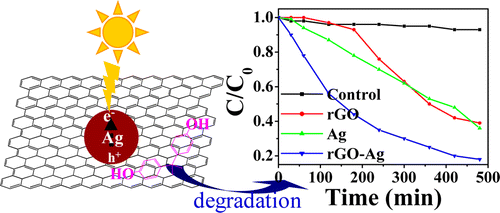Breaking down BPA and similar pollutants with sunlight, nanoparticles and graphene

Many pollutants with the potential to meddle with hormones—with bisphenol A (BPA) as a prime example—are already common in the environment. In an effort to clean up these pollutants found in the soil and waterways, scientists are now reporting a novel way to break them down by recruiting help from nanoparticles and light. The study appears in the journal ACS Applied Materials & Interfaces.
Nikhil R. Jana and Susanta Kumar Bhunia explain that the class of pollutants known as endocrine disruptors has been shown to either mimic or block hormones in animals, including humans. That interference can cause reproductive and other health problems. The compounds are used to make many household and industrial products, and have been detected in soil, water and even human breast milk. Scientists have been working on ways to harness sunlight to break down endocrine disruptors to make them less of a health threat. But the approaches so far only work with ultraviolet light, which at a mere 6 percent of sunlight, means these methods are not very efficient. Jana and Bhunia wanted to find a simple way to take advantage of visible light, which comprises 52 percent of sunlight.
For inspiration, the researchers turned to an already-developed graphene composite that uses visible light to degrade dyes. They tweaked the composite and loaded it with silver nanoparticles that serve as an antenna for visible light. When they tested it, the new material successfully degraded three different kinds of endocrine disruptors: phenol, BPA and atrazine. They conclude that their composite is a promising way to harness visible light to break down these potentially harmful compounds and other organic pollutants.
More information: "Reduced Graphene Oxide-Silver Nanoparticle Composite as Visible Light Photocatalyst for Degradation of Colorless Endocrine Disruptors" ACS Appl. Mater. Interfaces, Article ASAP, DOI: 10.1021/am505677x
Abstract
Sunlight-induced degradation of organic pollutants is an ideal approach for environmental pollution control and wastewater treatment. Although a variety of photocatalysts have been designed toward this goal, efficient degradation of colorless organic pollutants by visible light is a challenging issue. Here, we show that a reduced graphene oxide (rGO)-based composite with silver nanoparticle (rGO–Ag) can act as an efficient visible-light photocatalyst for the degradation of colorless organic pollutants. We have developed a simple, large-scale synthesis method for rGO–Ag and used it for the degradation of three well-known endocrine disruptors (phenol, bisphenol A, and atrazine) under UV and visible light. It is found that photocatalytic efficiency by rGO–Ag under visible light is significantly higher compared to that of rGO or silver nanoparticles. It is proposed that Ag nanoparticles offer visible-light-induced excitation of silver plasmons, and conductive rGO offers efficient charge separation and thus induces oxidative degradation of the organic pollutant. This approach can be extended for sunlight-induced degradation of different organic pollutants.
Journal information: ACS Applied Materials and Interfaces
Provided by American Chemical Society















